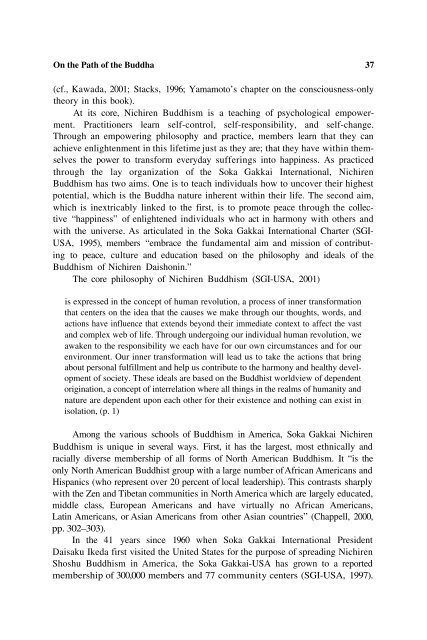Psychology & Buddhism.pdf
Psychology & Buddhism.pdf
Psychology & Buddhism.pdf
You also want an ePaper? Increase the reach of your titles
YUMPU automatically turns print PDFs into web optimized ePapers that Google loves.
On the Path of the Buddha 37<br />
(cf., Kawada, 2001; Stacks, 1996; Yamamoto’s chapter on the consciousness-only<br />
theory in this book).<br />
At its core, Nichiren <strong>Buddhism</strong> is a teaching of psychological empowerment.<br />
Practitioners learn self-control, self-responsibility, and self-change.<br />
Through an empowering philosophy and practice, members learn that they can<br />
achieve enlightenment in this lifetime just as they are; that they have within themselves<br />
the power to transform everyday sufferings into happiness. As practiced<br />
through the lay organization of the Soka Gakkai International, Nichiren<br />
<strong>Buddhism</strong> has two aims. One is to teach individuals how to uncover their highest<br />
potential, which is the Buddha nature inherent within their life. The second aim,<br />
which is inextricably linked to the first, is to promote peace through the collective<br />
“happiness” of enlightened individuals who act in harmony with others and<br />
with the universe. As articulated in the Soka Gakkai International Charter (SGI-<br />
USA, 1995), members “embrace the fundamental aim and mission of contributing<br />
to peace, culture and education based on the philosophy and ideals of the<br />
<strong>Buddhism</strong> of Nichiren Daishonin.”<br />
The core philosophy of Nichiren <strong>Buddhism</strong> (SGI-USA, 2001)<br />
is expressed in the concept of human revolution, a process of inner transformation<br />
that centers on the idea that the causes we make through our thoughts, words, and<br />
actions have influence that extends beyond their immediate context to affect the vast<br />
and complex web of life. Through undergoing our individual human revolution, we<br />
awaken to the responsibility we each have for our own circumstances and for our<br />
environment. Our inner transformation will lead us to take the actions that bring<br />
about personal fulfillment and help us contribute to the harmony and healthy development<br />
of society. These ideals are based on the Buddhist worldview of dependent<br />
origination, a concept of interrelation where all things in the realms of humanity and<br />
nature are dependent upon each other for their existence and nothing can exist in<br />
isolation, (p. 1)<br />
Among the various schools of <strong>Buddhism</strong> in America, Soka Gakkai Nichiren<br />
<strong>Buddhism</strong> is unique in several ways. First, it has the largest, most ethnically and<br />
racially diverse membership of all forms of North American <strong>Buddhism</strong>. It “is the<br />
only North American Buddhist group with a large number ofAfrican Americans and<br />
Hispanics (who represent over 20 percent of local leadership). This contrasts sharply<br />
with the Zen and Tibetan communities in North America which are largely educated,<br />
middle class, European Americans and have virtually no African Americans,<br />
Latin Americans, or Asian Americans from other Asian countries” (Chappell, 2000,<br />
pp. 302–303).<br />
In the 41 years since 1960 when Soka Gakkai International President<br />
Daisaku Ikeda first visited the United States for the purpose of spreading Nichiren<br />
Shoshu <strong>Buddhism</strong> in America, the Soka Gakkai-USA has grown to a reported<br />
membership of 300,000 members and 77 community centers (SGI-USA, 1997).











